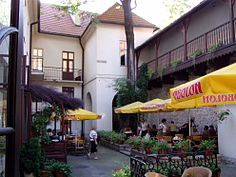 Kyivan Rus Foundation of St. Volodymyr in Kraków with courtyard patio of a fine dining restaurant | |
| Total population | |
|---|---|
| 5,400,000+ (2022)[1] | |
| Regions with significant populations | |
| Central: Warsaw; north east: Olsztyn, Elbląg; north west: Szczecin, Słupsk, Koszalin; south west: Legnica and Wrocław; south east: Lublin and Rzeszow | |
| Languages | |
| Ukrainian, Russian, Polish, Rusyn | |
| Religion | |
| Orthodox Christianity, Greek Catholicism | |
| Related ethnic groups | |
| Ukrainians in Lithuania |
Ukrainians in Poland (Ukrainian: Українці Польщі, romanized: Ukraintsi Polshchi; Polish: Ukraińcy w Polsce) have various legal statuses: ethnic minority, temporary and permanent residents, and refugees. According to the Polish census of 2011, the Ukrainian minority in Poland was composed of approximately 51,000 people (including 11,451 without Polish citizenship).[2] Some 38,000 respondents named Ukrainian as their first identity (28,000 as their sole identity), 13,000 as their second identity, and 21,000 declared Ukrainian identity jointly with Polish nationality.[3] However, these numbers have changed since the mid-2010s, with a large influx of economic immigrants and students[4] from Ukraine to Poland, with some estimating their total number at 2 million people.[5][4] Their status has been regulated according to the Polish and European Union (EU) policies of temporary work permits, temporary residence permits and permanent residence permits.[6] The number of Ukrainians in Poland rose dramatically following the Russian invasion of Ukraine on 24 February 2022. By 16 August 2022, more than 11.2 million Ukrainian refugees left the territory of Ukraine, of which more than 5.4 million people fled to neighbouring Poland.[7][8]
- ^ "Populacja cudzoziemców w Polsce w czasie COVID-19".
- ^ "Ludność. Stan i struktura demograficzno-społeczna. Narodowy Spis Powszechny Ludności i Mieszkań 2011" (PDF). Warsaw: GUS. 2013. p. 268.
- ^ Przynależność narodowo-etniczna ludności – wyniki spisu ludności i mieszkań 2011. GUS. Materiał na konferencję prasową w dniu 29. 01. 2013. p. 3. Retrieved 2013-03-06.
- ^ a b "2 млн украинцев работают в Польше — МИД Польши". delo.ua (in Ukrainian). 2 December 2018. Retrieved 17 June 2019.
- ^ Shotter, James; Huber, Evon (10 July 2018). "Polish companies target Ukrainian workers as consumers". ft.com. FINANCIAL TIMES. Retrieved 14 September 2018.
- ^ "Maps and statistics of migrants and Polish migration services". migracje.gov.pl. Urząd do Spraw Cudzoziemców (The Office for Foreigners). Retrieved 14 September 2018. (daily updated)
- ^ "Refugees fleeing Ukraine (since 24 February 2022)". UNHCR. 2022.
- ^ Cite error: The named reference
MSWIAwas invoked but never defined (see the help page).